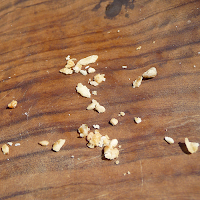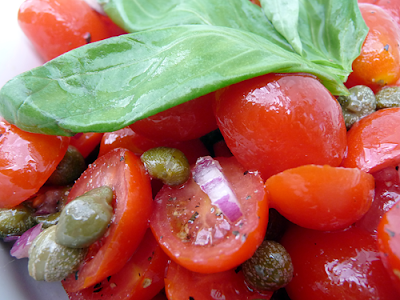The plants are closing in, but in a good way, a way that envelops you in a safe verdant blanket.
I can't quite believe how much everything has grown. Periods of rain have given way to some long warm sunny days, lately, and that has bestowed every leaf and shoot with a healthy boost.
It's all very good, but I've had to cut back some of the shrubs and overhanging branches, just so that I can get around the garden without having to duck or being snagged by wayward twigs.
Our garden is quite large, so we have tried to make it as low maintenance as possible, as there's not always enough time to be constantly tending to plants. We removed the lawn a few years ago and hauled barrow loads of gravel in to take its place. After taking the view that a lawn was largely a waste of time and moreover a waste of space, it seemed the best thing to. Before you lambast me for tearing up a green space, i would like to say that, in my defence, that we now have more plants and a small pond. The gravel has now become merely a set of pathways between areas and the garden looks far more attractive.
I have confession to make. I am not a tidy gardener, so things may be a bit straggly and unkempt. There are empty plant pots stacked up here and there and maybe a small heap of last year's tree prunings in a corner somewhere, but I've found that this has attracted an abundance of wildlife, something the garden never had when we first moved here nine years ago.
It would seem that, inadvertently, we have created a permaculture. There are some mature trees creating a canopy, shrubs beneath and then smaller plants. Much of the edible stuff such as tomatoes, potatoes and the like, we grow in pots right outside the kitchen door and the herbs are never far away either. Our instinctive planting layout has created the perfect microclimate, each plant supporting one another and we try to avoid nasty chemicals wherever possible.
We don't have a designated herb plot as the various plants reside throughout the entire garden, be they in the ground or in containers. I would say that the herbs make up most of the structure and are beautiful to look at, smell wonderful and are essential to my cooking.
The photo above is of a sage bush. It started life as small plant, given to me by my Mum, from a cutting she had taken from hers. The plants is huge now and of all the sages I have, is the only one that flowers. It certainly keeps the bees well fed and as soon as the sun is out, I can hear the buzzing as the bees bob from flower to flower gathering nectar.
Below is a purple sage. It may not flower but the leaves are very attractive.
I love the taste of sage, but you don't need to use very much of it as it has a very strong flavour, which can be quite medicinal in nature.
It dries very well, so is one of the best herbs for winter storage, especially as it adopts a sad droopy look during the colder months. Drying is very easy to do, just clip of large sprigs (I tend to do this when I'm pruning the plant) and then bunch them together and tie with string. Hang them upside down in a warm, dry, well ventilated space for a week or so. When they are completely dry, crumble in to airtight jars.
One of my other favourite herbs is rosemary, the smell is heavenly. Just a few sprigs can perk up roast potatoes and of course it's great with lamb.
Rosemary is fantastic all year round, it is the only one that retains its glory through the winter, so I've never needed to dry it. I've been known to dash down a frosty garden to clip some for dinner!
We're relatively new to fruit growing, we've had a couple of failures, notably mystery blueberry deaths and non-fruiting gooseberries, but so far the raspberry has been a success. This year it is a mass of flowers and they're looking pretty good, with the exception of some greenfly which the ants are farming. I think if we can keep these bugs off with a little organic spray, they should be OK.
Good to see the bees like the raspberry flowers, too – pollination is important.
Yes I know this basil plant looks a little worse for wear but if you saw it a couple of weeks ago, you'd have though it was destined for the dustbin!
It's one of those supermarket ones and usually they don't last that long, so after I gave it the haircut of it's life when making a pesto, I thought it was a goner. Just as I was about to dispose of it, my husband stopped me, saying "it might grow back". I was quite sceptical at this point, but put it back on the windowsill. Lo and behold, it did grow back! I'm continuing to water it and let it outside during good weather to "sunbathe" and seems to be flourishing.
One of our trees is an almond that came with the garden, I would say it is as old as the house, probably 90 years or so. It is festooned with gorgeous pink blossom in the early spring which later develops into fuzzy green fruits. I've never actually eaten the almonds inside, so the local squirrels get those.
The tree has done so well since the old asbestos garage was demolished and without competition, the tree has grown and spread. However, it is not without a few problems. Every year, without fail, it succumbs to the dreaded peach leaf curl. Some leaves mutate into crinkly red freaks and the ones that remain untouched by the fungal infection, present themselves peppered with holes. I believe some kind creepy crawly is responsible. I'd say it is armed with a hole punch as those holes are perfectly spherical.
I grow the lemon balm in a large trough together with the mint as they both have the inclination to spread wherever they please. I've started to use lemon balm mixed with green tea. It makes a lovely relaxing infusion with citrusy notes.
I always look forward to the mint returning in spring. It's always best used fresh.
This year, the oregano has become rather prolific and has made a fantastic green cushion in the trough. I love using it with olive oil and lemon juice as a marinade for chicken before chargrilling.
More lemon flavours in form of lemon thyme. Again, this is great with chicken and also fish. The plant was looking a little forlorn and then it picked up when new green shoots began to appear on the twiggy mess it once was.
Maybe I've planted these somewhat late, but I though it worth a try, as I love french beans. There's nothing better than a fresh picked, young and tender pod.
The bean plants may only be small but they have flower buds, so that's promising.
This is florence fennel that I started growing last year, although it didn't bulb up, I have been using the leaves as a herb. I'm hoping that this year I might get some bulbs at the bottom, failing that, I've discovered that the flowers are supremely delicious. I was reading about fennel pollen the other day, apparently it is very sought after by posh restaurants and valuable too. Is this what I have?
The peas were as late as the beans going in, but they're going great guns. Those tendrils are finding the sticks and winding their way up. Sometimes when I'm sitting outside, I swear I can see those tendrils moving and twisting.
I like to grow potatoes in containers, it makes it so much easier to harvest them. As I only want small new potatoes, this works just fine. After the potatoes have finished flowering, I start removing the soil and perfect little potatoes are revealed.
Baby salad leaves are really easy to grow. To get a succession throughout the summer I sow several containers at eight week intervals and this gives me a plentiful supply of small juicy leaves.
The ones I have growing are a peppery mixture with my favourites, the red mustard.
Providing I can keep aphids, leaf miner, carrot fly, snails, slugs and even the squirrels (they like to excavate the pots) at bay, my kitchen garden should keep us relatively well fed.
 Lactose is present in many things that you'd not expect, including crisps and biscuits, so it is not easily avoided. There are dairy substitutes such as soya or rice milk, but I know some people who find these unpalatable, forcing them to give up anything milk-like all together.
Lactose is present in many things that you'd not expect, including crisps and biscuits, so it is not easily avoided. There are dairy substitutes such as soya or rice milk, but I know some people who find these unpalatable, forcing them to give up anything milk-like all together. I also tried the semi hard cheese, which has a slightly springy texture, but is creamy in the mouth, with a slightly tangy taste, not unlike Edam. It behaves just like normal cheese and melts well in cooking.
I also tried the semi hard cheese, which has a slightly springy texture, but is creamy in the mouth, with a slightly tangy taste, not unlike Edam. It behaves just like normal cheese and melts well in cooking. There is a soft white cheese available too, which is great for spreading and would be perfect for making a creamy pasta sauce or for whipping up into frosting for a carrot cake (made with oil instead of butter, of course).
There is a soft white cheese available too, which is great for spreading and would be perfect for making a creamy pasta sauce or for whipping up into frosting for a carrot cake (made with oil instead of butter, of course).




















































